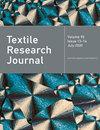减少纺织业的碳足迹:影响和解决方案概览
IF 1.9
4区 工程技术
Q2 MATERIALS SCIENCE, TEXTILES
引用次数: 0
摘要
服装、鞋类和家用纺织品行业发挥着重要作用,在全球范围内提供就业机会。然而,这些行业也消耗大量自然资源,造成严重的水污染和温室气体排放,加剧了气候变化。纺织品的碳足迹(CF)一般取决于织物类型和生产工艺。与涤纶和尼龙等合成织物相比,棉、羊毛和丝绸等天然纤维的碳足迹通常较低,因为它们在生产过程中需要更多的能源和化学品。此外,通过生态友好型方法(如闭环系统和可持续生产工艺)生产的织物,其 CF 值明显低于使用传统方法生产的织物。因此,人们认为有必要对纺织业对环境和气候的影响进行全面研究。考虑到这些问题,我们就这一主题开展了一项研究,包括文献综述和数据收集,以概述与纺织业相关的环境影响和 CF。研究结果表明,与纺织业相关的资源消耗,特别是其碳捕获量,需要采取紧急行动以减少其影响。此外,还需要采取可行的措施,以减少纺织业的 CF。本文介绍了这些措施,以及需要克服的障碍,以便不仅减少该行业的 CF,而且实现可持续发展目标中列出的各项目标。本文章由计算机程序翻译,如有差异,请以英文原文为准。
Reducing the carbon footprint of the textile sector: an overview of impacts and solutions
The clothing, footwear, and household textiles sectors play a significant role, providing employment opportunities on a global scale. However, they are also associated with a considerable consumption of natural resources, leading to high levels of water pollution and emissions of greenhouse gases, contributing to climate change. The carbon footprint (CF) of textiles depends generally on fabric types and production processes. Natural fibers such as cotton, wool, and silk, generally have a lower CF when compared to synthetic fabrics such as polyester and nylon, requiring more energy and chemicals during production. In addition, fabrics manufactured through eco-friendly methods, such as closed-loop systems and sustainable production processes, have a significantly lower CF than those produced using conventional means. Accordingly, there is a perceived need for comprehensive studies that investigate the environmental and climate implications of the textile sector. Considering these concerns, a study was undertaken on the topic, encompassing a literature review and data collection so as to present an overview of the environmental impacts and CF associated with the textile sector. The results from the research show that the resource consumption associated with the textile sector, particularly its CF, demands urgent action in order to reduce its impacts. Also, actionable measures are needed so as to reduce the CF of the textile industry. These are described in the paper, along with the obstacles that need to be overcome so as not only to reduce the CF of this sector, but also to pursue the objectives outlined in the sustainable development goals.
求助全文
通过发布文献求助,成功后即可免费获取论文全文。
去求助
来源期刊

Textile Research Journal
工程技术-材料科学:纺织
CiteScore
4.00
自引率
21.70%
发文量
309
审稿时长
1.5 months
期刊介绍:
The Textile Research Journal is the leading peer reviewed Journal for textile research. It is devoted to the dissemination of fundamental, theoretical and applied scientific knowledge in materials, chemistry, manufacture and system sciences related to fibers, fibrous assemblies and textiles. The Journal serves authors and subscribers worldwide, and it is selective in accepting contributions on the basis of merit, novelty and originality.
 求助内容:
求助内容: 应助结果提醒方式:
应助结果提醒方式:


